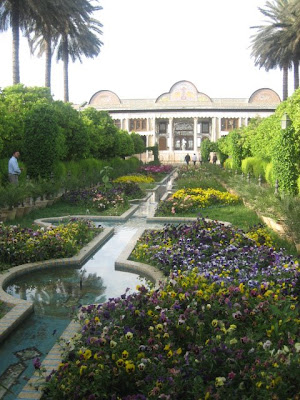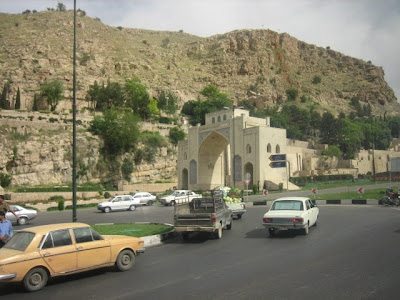Salaam,
A tour of Iran seems to me to be incomplete without stopping by in Shiraz. So a visit to this world’s famous historical and beautiful city should be the top most priority in every adventurer’s tour itinerary. And I must confide that of all the places we’ve visited thus far, Shiraz mesmerized me the most.
Fars province and Shiraz city in particular, with its diverse historical and cultural structures are indeed the symbol of Iran’s history and culture. Historical structures like the Persepolis complex of palaces, mausoleums of legendary kings, holy monuments, beautiful gardens and the tombs of the greatest of Persian poets, all and all make the province and the city, one of the focal point of attraction and popularly visited areas in Iran.
As in our previous tours of Iranian cities and provinces, our two-day diplomatic trip to Shiraz was once again organized and conducted by the Iranian Foreign Ministry in coordination with the Iran Tourism and Cultural Heritage Organization. The organizer had also been kind enough to invite us – the trailing spouses, to accompany our better halves.
The visit was also arranged in conjunction with the ‘Shiraz Day Ceremony’ held in commemoration of the founding of the city. It was still early May 2007 and the weather was just perfect. Actually a thorough visit to Shiraz may take more than a couple of days. Nonetheless the well-coordinated program enabled us to explore this charming and pleasant city to our great satisfaction despite our relatively short period of stay.
Upon arrival at Shiraz airport, we’re directly led on to our first program of the day – a visit to the tomb of Hafez. From the tomb of Hafez, off to Arg-e Karim Khan (citadel of Karim Khan) and later in the evening we’re again led to a tour of a mausoleum of another great Iranian poet, Sa’adi.
Admired for its role in literacy, scientific and religious elites, Shiraz is a reminder of the eternal nature of Persian literature and poetry. The peak of its prosperity was during the reign of Karim Khan Zand when it became the country’s capital. An important centre for Iranian culture, the city has introduced a number of famous poets. Shiraz is the birthplace and resting place of the great Persian poets Hafez, the master of Persian lyrical poetry; and Saadi, the author of the famous Golestan, a book of sonnets called the Garden of Roses. Their tombs are the two most remarkable monuments in the city.
Located in the northeast of the city, the citadel of Karim Khan was built as part of a complex during the Zand dynasty and named after its famous ruler, Karim Khan in the mid 18th century. Its shape resembles a medieval fortress, at times used as a prison and today converted into a museum. It is one of the best-preserved examples of urban fortifications in Iran.
Shiraz has since old times been known as the city of flowers and nightingales. Indeed the city lays spread out like an immense garden on a green plain at the foot of the Tang Allah-o-Akbar Mountains. The city’s beautiful gardens are renowned worldwide. Hence our everlasting impression of this beautiful city remained with our beautiful memories.
One of the most impressive example of a traditional Shirazi garden and mansion that we visited is the 19th century Bagh-e Naranjestan or Citrus Orchard. A magnificent complex, Naranjestan-e Qavam was built by Mohammad Ali Khan Qavam al-Molk during the Qajar period and served as the official residence of the Qavam family and was a showcase for their power and wealth.
Another most renowned garden in Shiraz is the Bagh-e Eram. This idyllic garden is a striking location to visit with its enchanting and historic mansion and a variety of plants. The beautiful three storey pavilion of the garden was designed on the lines of Safavid and Qajari styles of architecture.
Today all of the gardens in Shiraz are holiday resorts for both the local as well as for the tourists. They are all remarkable examples of the art of Persian gardening.
Virtually no Iranian town or city exists without its bazaar. In Shiraz, the most famous is the Vakil (Regent’s) Bazaar. Needless to say, this is a ‘must’ for the trailing ladies to visit, or at least to window shop (which we did on the second day). Shiraz is a great place to buy souvenirs. The best items to buy for here are carpets, jewelry, silver and bronze smithing, textiles, embroidery, khatam (marquetry mosaic) and spices.
Persepolis
The highlight of every visitor’s trip to Shiraz is a tour of the most awesome ruins of the ancient world - the Persepolis. On the second day of our visit, we left Homa hotel early morning for an hour’s excursion to this spectacular monument.
Located in the Marvdasht Plain some 50 km northeast of Shiraz, at the foot of the Rahmat Mountains, one encounters the vast platform and remains of Persepolis, the grand ceremonial capital built by Darius I (Darius the Great) and his successors some 2500 years ago. Persepolis flourished for about two centuries until it was plundered, burned and left in ruins by Alexander the Great in 330 B.C.
This magnificent site embodies the greatest success of the ancient Achaemenid Empire. It is undoubtedly the greatest surviving masterpiece of the ancient Near Eastern civilizations.
The Persepolis, known to Iranians as Takht-e Jamshid, is a very remarkable example of ancient monuments of Iran. The scope and grandeur of its structures, even in their ruined state, have made the city one of the most impressive sights surviving from antiquity.
The cradle of Iranian civilization, the city of poets, and the garden city….Shiraz is simply awe-inspiring!!
Wassalam.
 mausoleum of Hafez
mausoleum of Hafez young Shirazis...
young Shirazis... with my Kenyan friend
with my Kenyan friend some of our tour group...at Hafez tomb
some of our tour group...at Hafez tomb then a visit to the Arg-e Karim Khan (citadel)
then a visit to the Arg-e Karim Khan (citadel)patterns...
 interior of the citadel
interior of the citadel
 old photo in the gallery
old photo in the gallery
 beautifully carved wooden window
beautifully carved wooden window
 replica of the court of the Zand ruler
replica of the court of the Zand ruler
 interior of the citadel
interior of the citadel old photo in the gallery
old photo in the gallery beautifully carved wooden window
beautifully carved wooden window replica of the court of the Zand ruler
replica of the court of the Zand ruler

























Iranian Rugs are popular all over the world.
ReplyDeleteShiraz rugs are hand knotted creations featuring geometric designs with plants and animals.